tow MAZDA MODEL 3 HATCHBACK 2013 (in English) Owner's Manual
[x] Cancel search | Manufacturer: MAZDA, Model Year: 2013, Model line: MODEL 3 HATCHBACK, Model: MAZDA MODEL 3 HATCHBACK 2013Pages: 611, PDF Size: 5.61 MB
Page 463 of 611
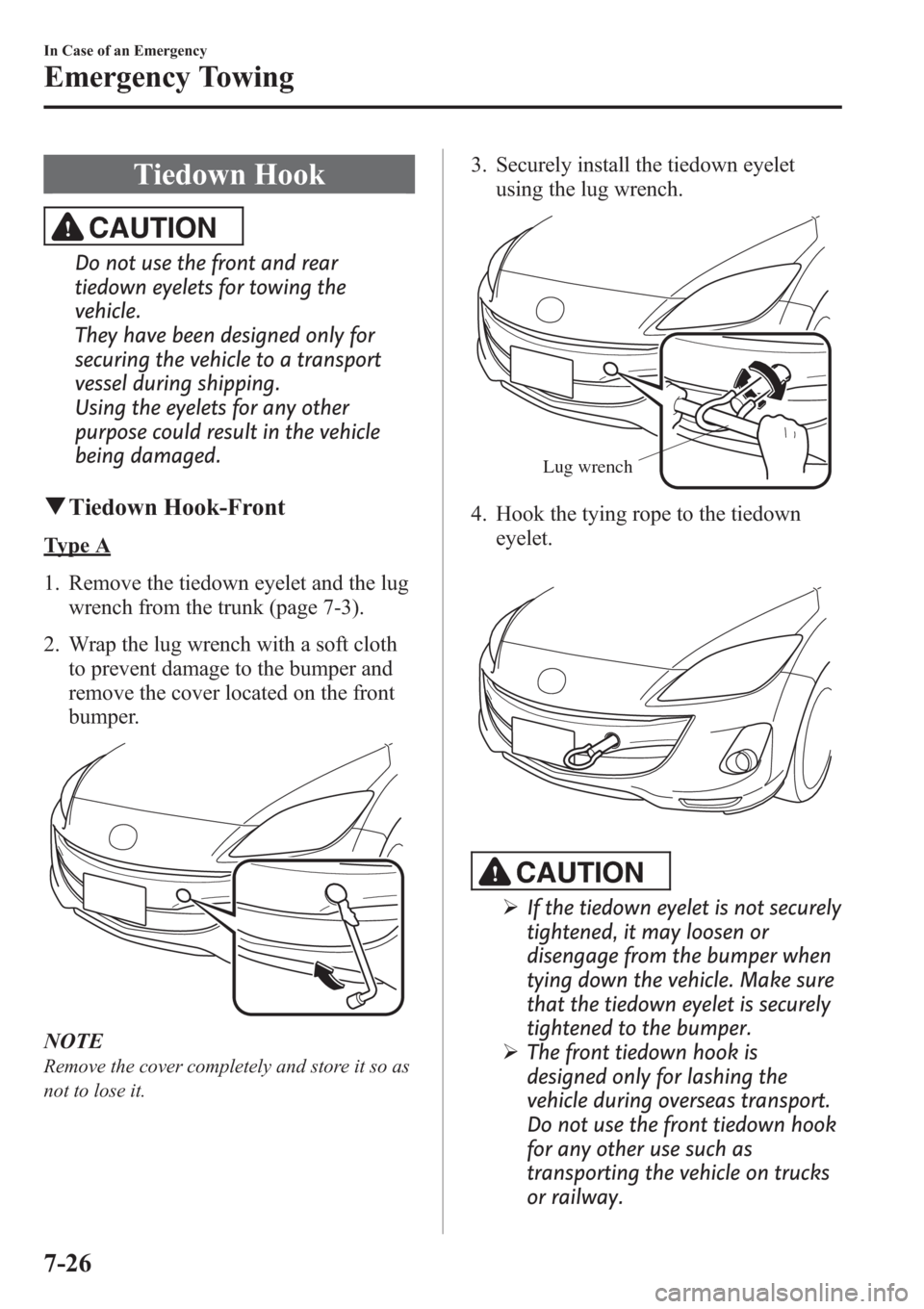
Tiedown Hook
CAUTION
Do not use the front and rear
tiedown eyelets for towing the
vehicle.
They have been designed only for
securing the vehicle to a transport
vessel during shipping.
Using the eyelets for any other
purpose could result in the vehicle
being damaged.
qTiedown Hook-Front
Type A
1. Remove the tiedown eyelet and the lug
wrench from the trunk (page 7-3).
2. Wrap the lug wrench with a soft cloth
to prevent damage to the bumper and
remove the cover located on the front
bumper.
NOTE
Remove the cover completely and store it so as
not to lose it.
3. Securely install the tiedown eyelet
using the lug wrench.
Lug wrench
4. Hook the tying rope to the tiedown
eyelet.
CAUTION
ØIf the tiedown eyelet is not securely
tightened, it may loosen or
disengage from the bumper when
tying down the vehicle. Make sure
that the tiedown eyelet is securely
tightened to the bumper.
ØThe front tiedown hook is
designed only for lashing the
vehicle during overseas transport.
Do not use the front tiedown hook
for any other use such as
transporting the vehicle on trucks
or railway.
7-26
In Case of an Emergency
Emergency Towing
Page 464 of 611
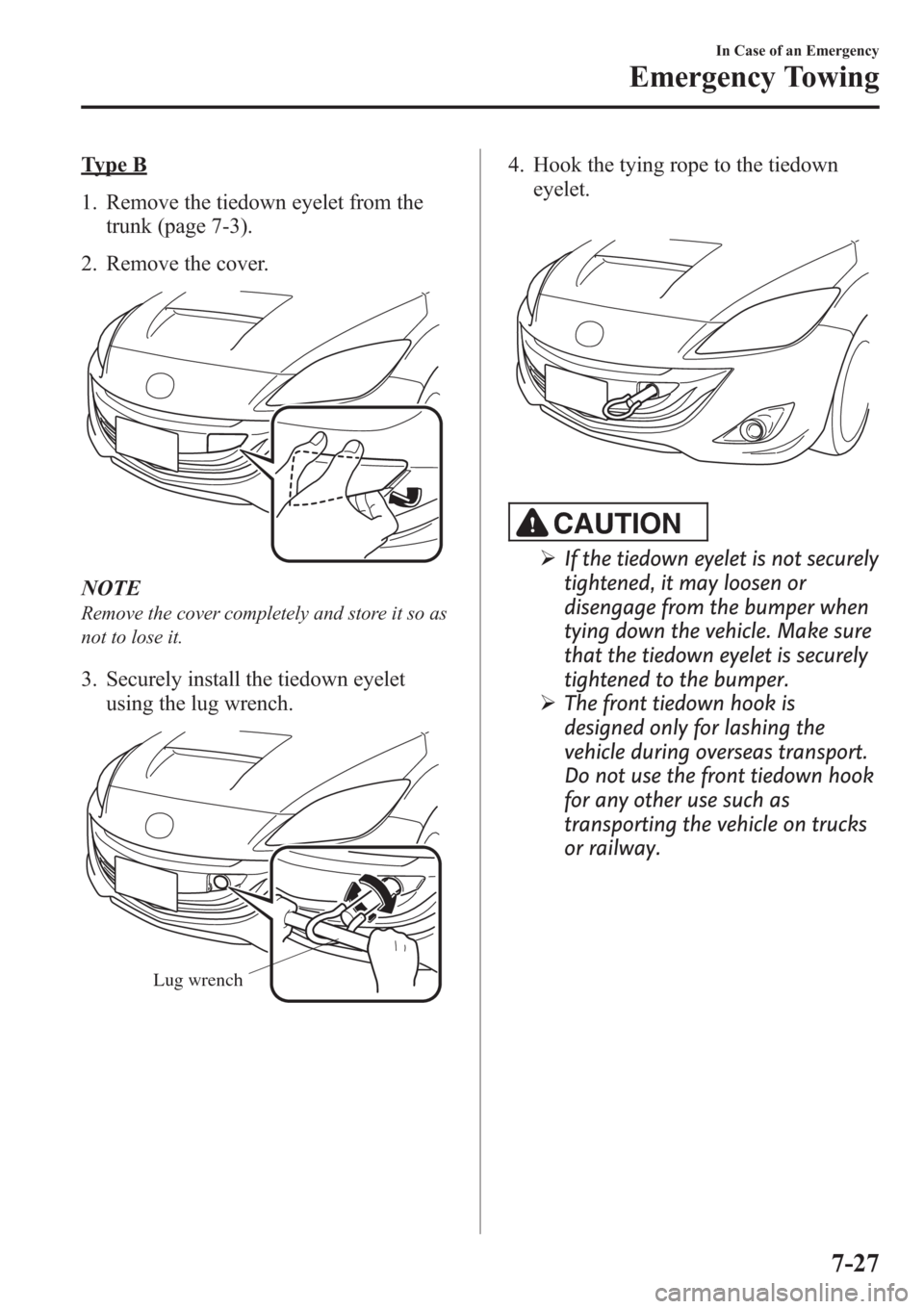
Type B
1. Remove the tiedown eyelet from the
trunk (page 7-3).
2. Remove the cover.
NOTE
Remove the cover completely and store it so as
not to lose it.
3. Securely install the tiedown eyelet
using the lug wrench.
Lug wrench
4. Hook the tying rope to the tiedown
eyelet.
CAUTION
ØIf the tiedown eyelet is not securely
tightened, it may loosen or
disengage from the bumper when
tying down the vehicle. Make sure
that the tiedown eyelet is securely
tightened to the bumper.
ØThe front tiedown hook is
designed only for lashing the
vehicle during overseas transport.
Do not use the front tiedown hook
for any other use such as
transporting the vehicle on trucks
or railway.
In Case of an Emergency
Emergency Towing
7-27
Page 465 of 611
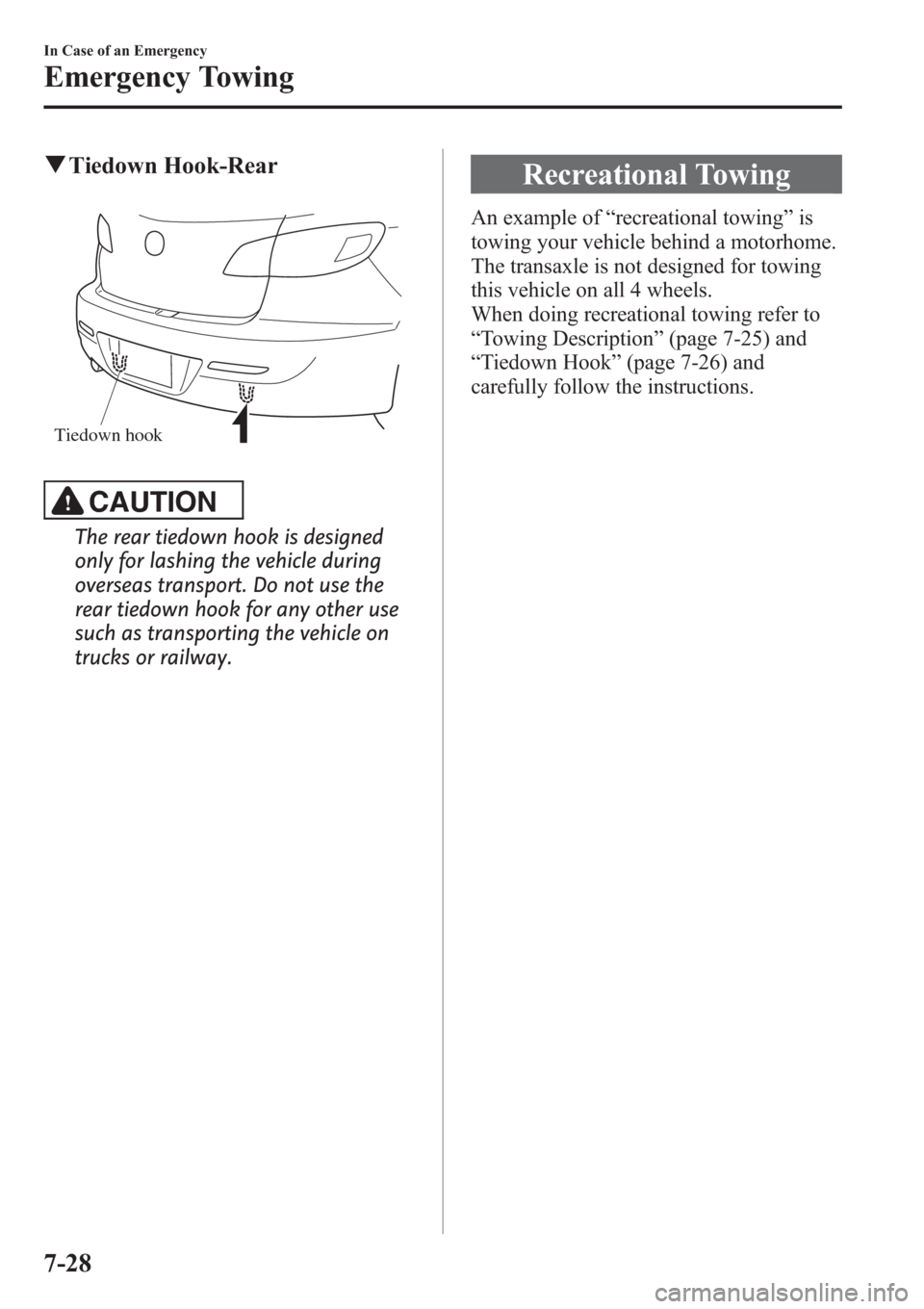
qTiedown Hook-Rear
Tiedown hook
CAUTION
The rear tiedown hook is designed
only for lashing the vehicle during
overseas transport. Do not use the
rear tiedown hook for any other use
such as transporting the vehicle on
trucks or railway.
Recreational Towing
An example of“recreational towing”is
towing your vehicle behind a motorhome.
The transaxle is not designed for towing
this vehicle on all 4 wheels.
When doing recreational towing refer to
“Towing Description”(page 7-25) and
“Tiedown Hook”(page 7-26) and
carefully follow the instructions.
7-28
In Case of an Emergency
Emergency Towing
Page 497 of 611

2. Hold the end of the rubber and pull
until the tabs are free of the metal
support.
Metal support
Ta b
3. Remove the metal stiffener from each
blade rubber and install them in the
new blade.
CAUTION
ØDon't bend or discard the stiffener.
You need to use them again.
ØIf the metal stiffeners are
switched, the blade's wiping
efficiency could be reduced.
So don't use the driver's side metal
stiffener on the passenger's side,
or vice versa.
ØBe sure to reinstall the metal
stiffener in the new blade rubber
so that the curve is the same as it
was in the old blade rubber.
4. Carefully insert the new blade rubber.
Then install the blade assembly in the
reverse order of removal.
NOTE
Install the blade so that the tabs are toward the
bottom of the wiper arm.
qReplacing Rear Wiper Blade (5
Door)
When the wiper no longer cleans well, the
blade is probably worn or cracked.
Replace it.
8-32
Maintenance and Care
Owner Maintenance
Page 536 of 611
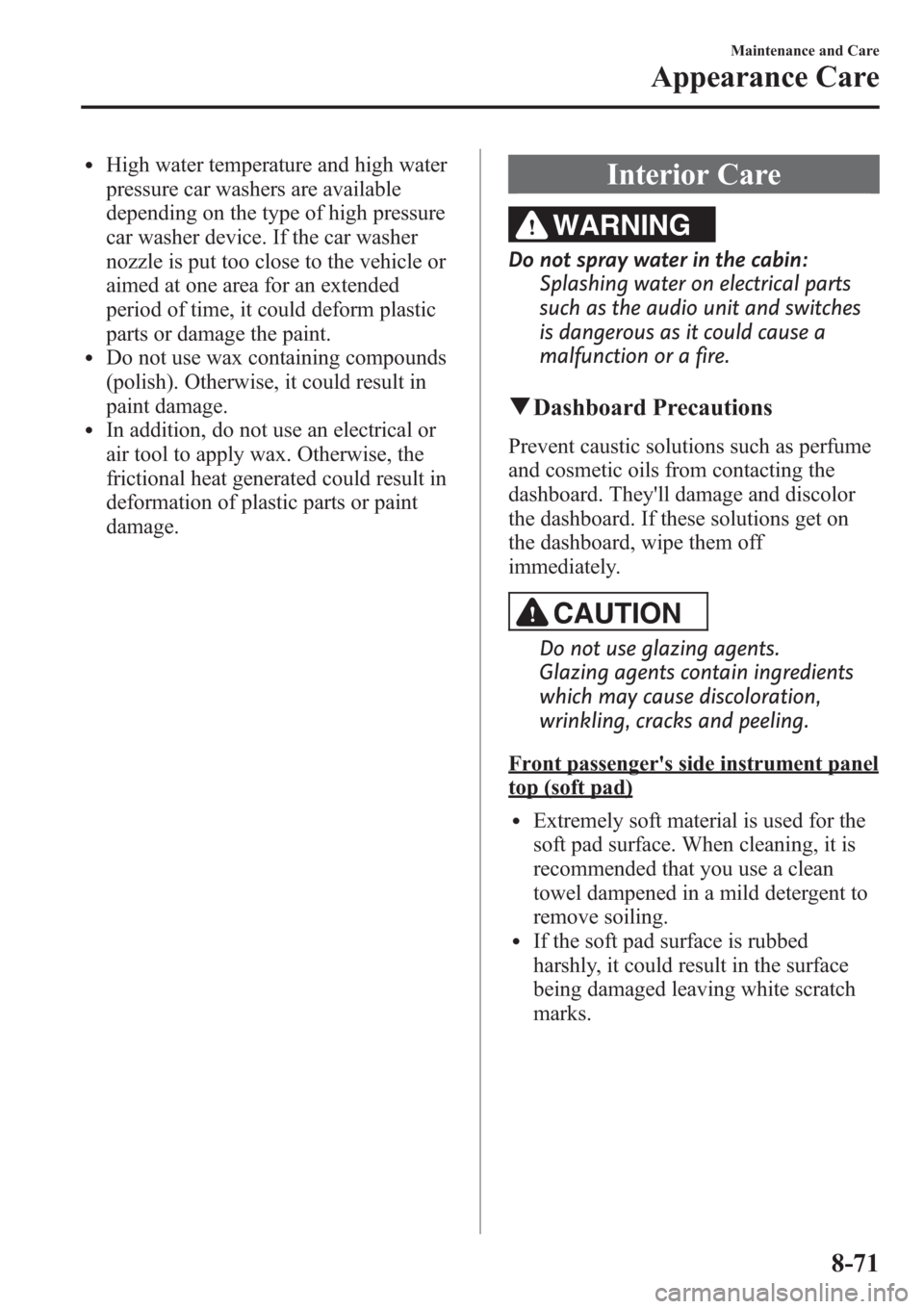
lHigh water temperature and high water
pressure car washers are available
depending on the type of high pressure
car washer device. If the car washer
nozzle is put too close to the vehicle or
aimed at one area for an extended
period of time, it could deform plastic
parts or damage the paint.
lDo not use wax containing compounds
(polish). Otherwise, it could result in
paint damage.
lIn addition, do not use an electrical or
air tool to apply wax. Otherwise, the
frictional heat generated could result in
deformation of plastic parts or paint
damage.
Interior Care
WARNING
Do not spray water in the cabin:
Splashing water on electrical parts
such as the audio unit and switches
is dangerous as it could cause a
malfunction or a fire.
qDashboard Precautions
Prevent caustic solutions such as perfume
and cosmetic oils from contacting the
dashboard. They'll damage and discolor
the dashboard. If these solutions get on
the dashboard, wipe them off
immediately.
CAUTION
Do not use glazing agents.
Glazing agents contain ingredients
which may cause discoloration,
wrinkling, cracks and peeling.
Front passenger's side instrument panel
top (soft pad)
lExtremely soft material is used for the
soft pad surface. When cleaning, it is
recommended that you use a clean
towel dampened in a mild detergent to
remove soiling.
lIf the soft pad surface is rubbed
harshly, it could result in the surface
being damaged leaving white scratch
marks.
Maintenance and Care
Appearance Care
8-71
Page 573 of 611
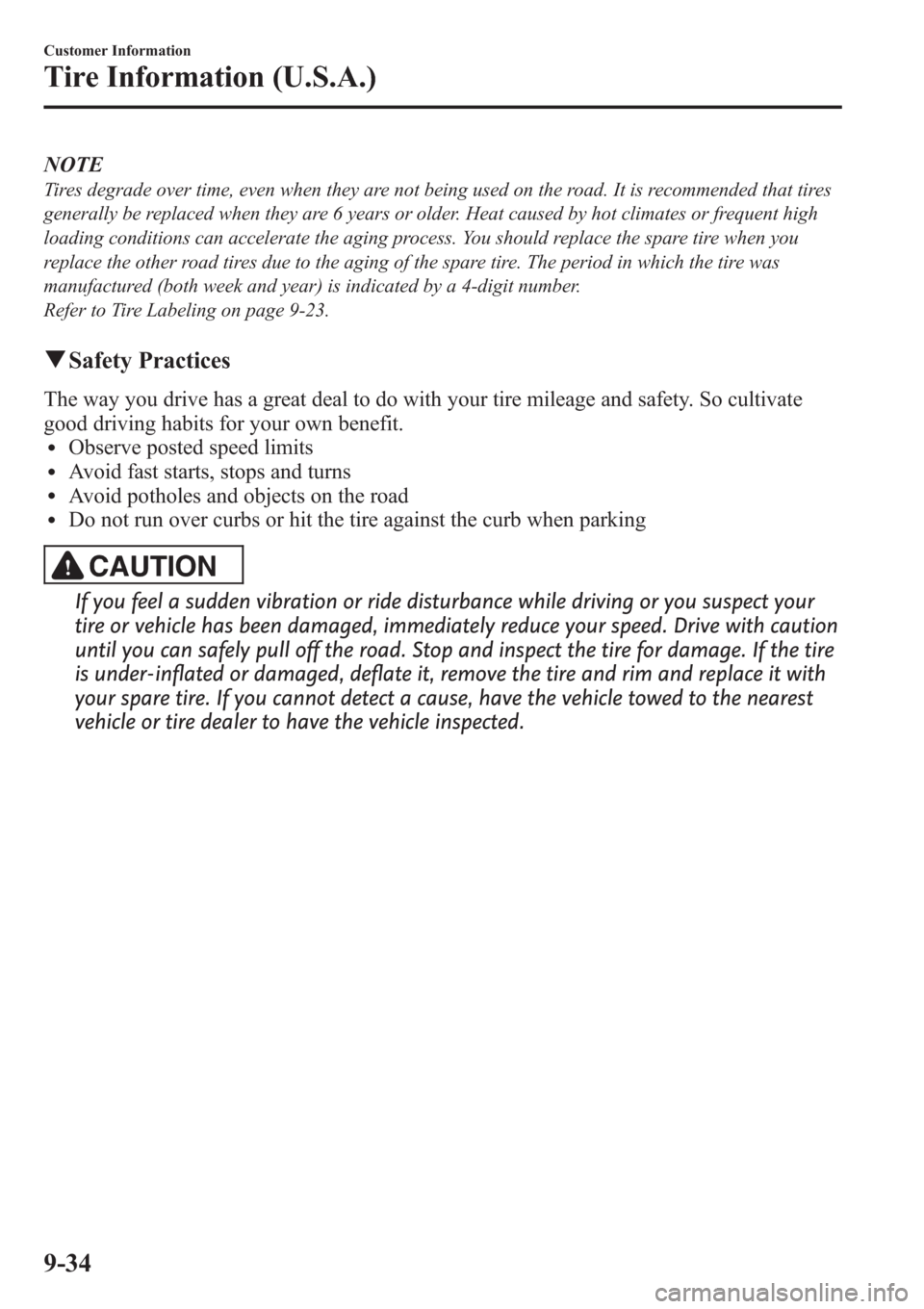
NOTE
Tires degrade over time, even when they are not being used on the road. It is recommended that tires
generally be replaced when they are 6 years or older. Heat caused by hot climates or frequent high
loading conditions can accelerate the aging process. You should replace the spare tire when you
replace the other road tires due to the aging of the spare tire. The period in which the tire was
manufactured (both week and year) is indicated by a 4-digit number.
Refer to Tire Labeling on page 9-23.
qSafety Practices
The way you drive has a great deal to do with your tire mileage and safety. So cultivate
good driving habits for your own benefit.
lObserve posted speed limitslAvoid fast starts, stops and turnslAvoid potholes and objects on the roadlDo not run over curbs or hit the tire against the curb when parking
CAUTION
If you feel a sudden vibration or ride disturbance while driving or you suspect your
tire or vehicle has been damaged, immediately reduce your speed. Drive with caution
until you can safely pull off the road. Stop and inspect the tire for damage. If the tire
is under-inflated or damaged, deflate it, remove the tire and rim and replace it with
your spare tire. If you cannot detect a cause, have the vehicle towed to the nearest
vehicle or tire dealer to have the vehicle inspected.
9-34
Customer Information
Tire Information (U.S.A.)
Page 574 of 611
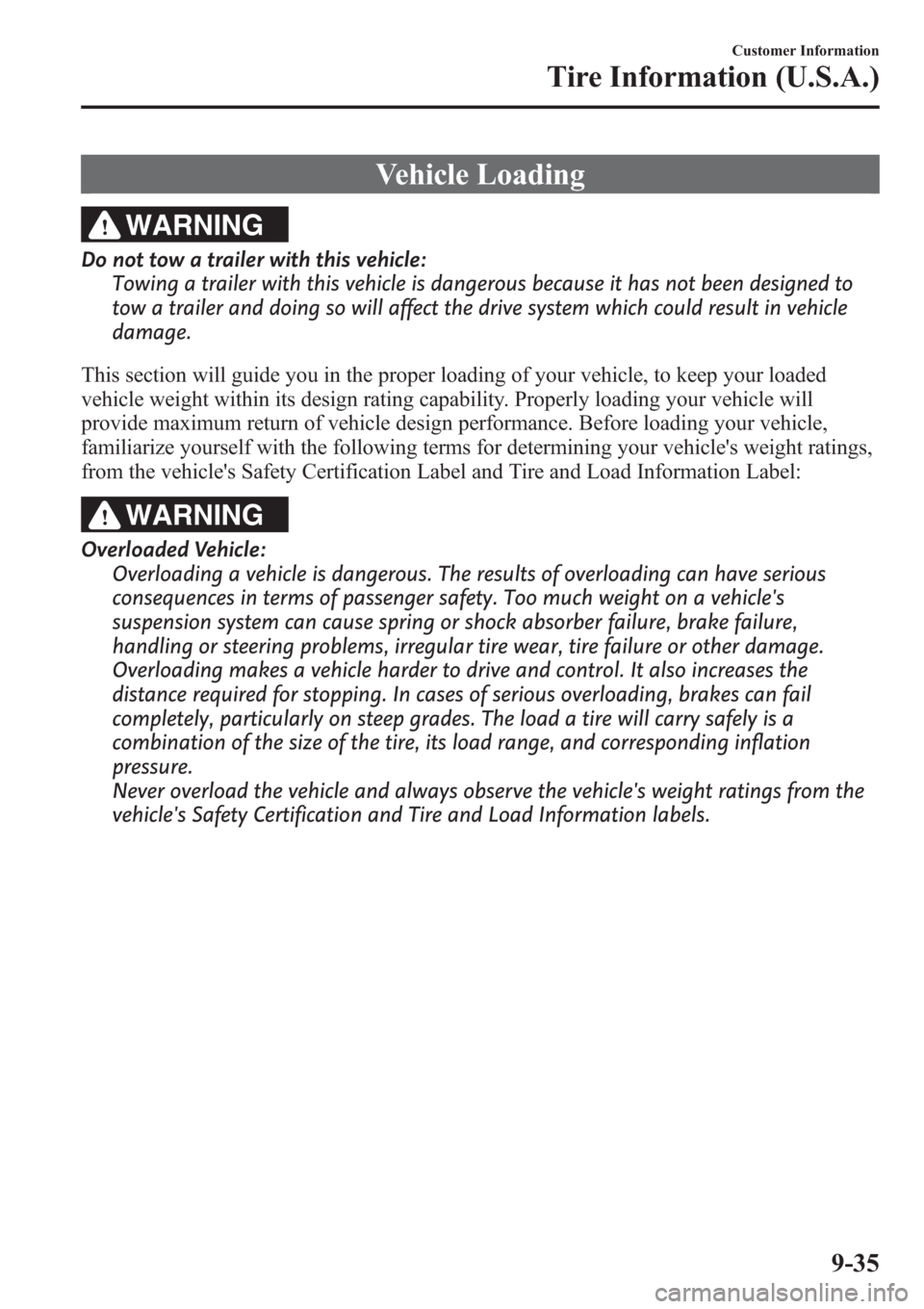
Vehicle Loading
WARNING
Do not tow a trailer with this vehicle:
Towing a trailer with this vehicle is dangerous because it has not been designed to
tow a trailer and doing so will affect the drive system which could result in vehicle
damage.
This section will guide you in the proper loading of your vehicle, to keep your loaded
vehicle weight within its design rating capability. Properly loading your vehicle will
provide maximum return of vehicle design performance. Before loading your vehicle,
familiarize yourself with the following terms for determining your vehicle's weight ratings,
from the vehicle's Safety Certification Label and Tire and Load Information Label:
WARNING
Overloaded Vehicle:
Overloading a vehicle is dangerous. The results of overloading can have serious
consequences in terms of passenger safety. Too much weight on a vehicle's
suspension system can cause spring or shock absorber failure, brake failure,
handling or steering problems, irregular tire wear, tire failure or other damage.
Overloading makes a vehicle harder to drive and control. It also increases the
distance required for stopping. In cases of serious overloading, brakes can fail
completely, particularly on steep grades. The load a tire will carry safely is a
combination of the size of the tire, its load range, and corresponding inflation
pressure.
Never overload the vehicle and always observe the vehicle's weight ratings from the
vehicle's Safety Certification and Tire and Load Information labels.
Customer Information
Tire Information (U.S.A.)
9-35
Page 578 of 611
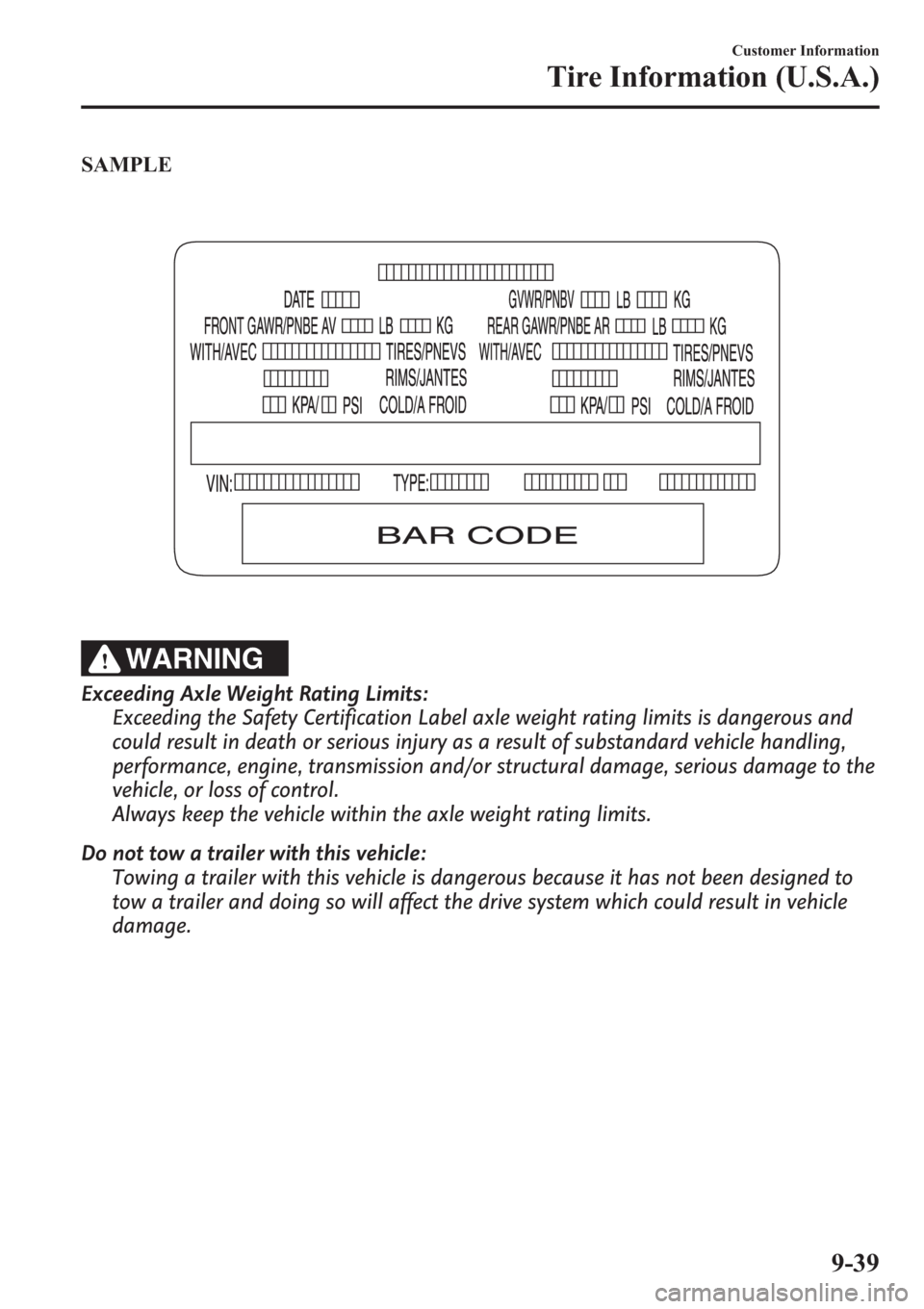
SAMPLE
WARNING
Exceeding Axle Weight Rating Limits:
Exceeding the Safety Certification Label axle weight rating limits is dangerous and
could result in death or serious injury as a result of substandard vehicle handling,
performance, engine, transmission and/or structural damage, serious damage to the
vehicle, or loss of control.
Always keep the vehicle within the axle weight rating limits.
Do not tow a trailer with this vehicle:
Towing a trailer with this vehicle is dangerous because it has not been designed to
tow a trailer and doing so will affect the drive system which could result in vehicle
damage.
Customer Information
Tire Information (U.S.A.)
9-39
Page 580 of 611
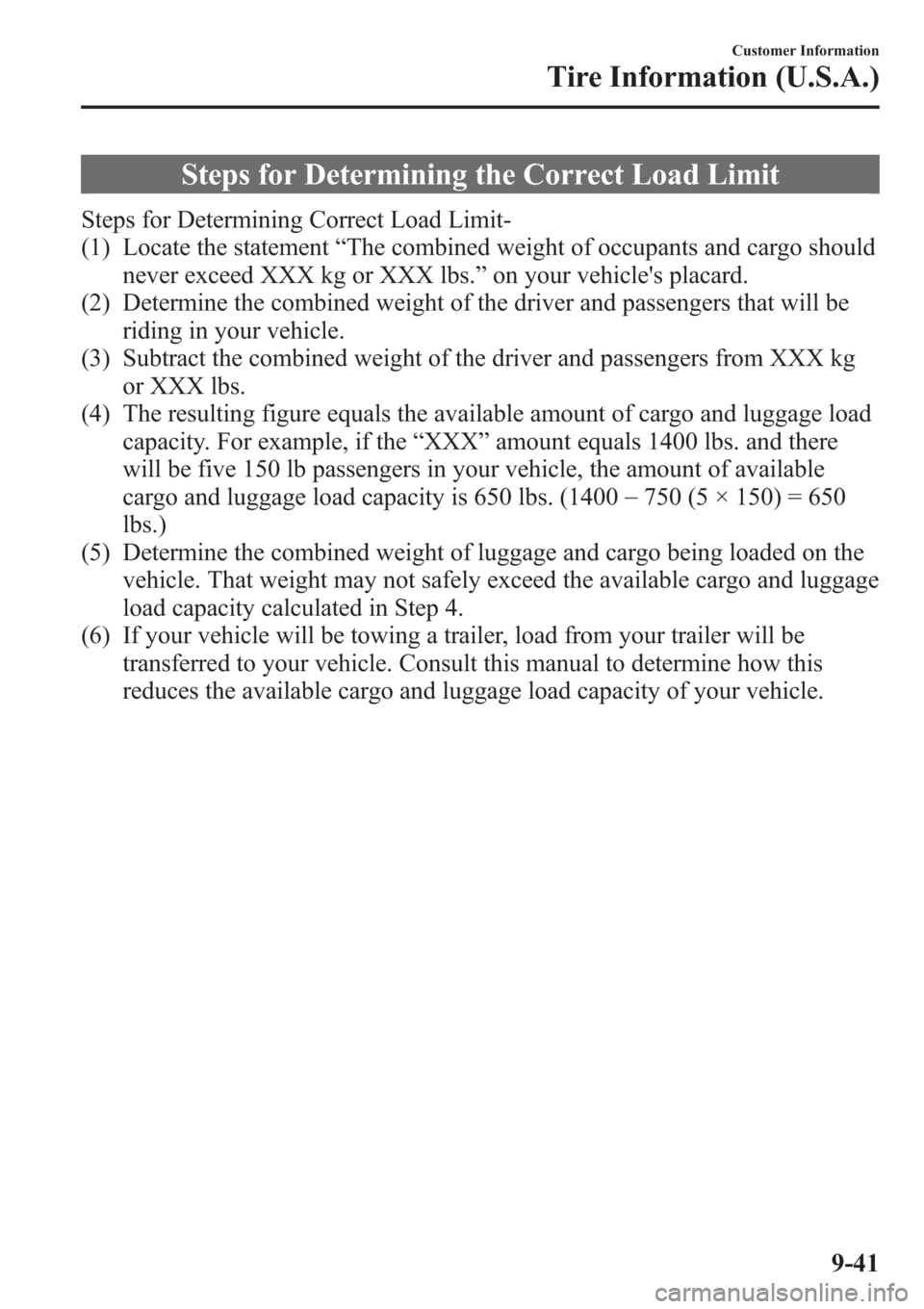
Steps for Determining the Correct Load Limit
Steps for Determining Correct Load Limit-
(1) Locate the statement“The combined weight of occupants and cargo should
never exceed XXX kg or XXX lbs.”on your vehicle's placard.
(2) Determine the combined weight of the driver and passengers that will be
riding in your vehicle.
(3) Subtract the combined weight of the driver and passengers from XXX kg
or XXX lbs.
(4) The resulting figure equals the available amount of cargo and luggage load
capacity. For example, if the“XXX”amount equals 1400 lbs. and there
will be five 150 lb passengers in your vehicle, the amount of available
cargo and luggage load capacity is 650 lbs. (1400_
750 (5 × 150) = 650
lbs.)
(5) Determine the combined weight of luggage and cargo being loaded on the
vehicle. That weight may not safely exceed the available cargo and luggage
load capacity calculated in Step 4.
(6) If your vehicle will be towing a trailer, load from your trailer will be
transferred to your vehicle. Consult this manual to determine how this
reduces the available cargo and luggage load capacity of your vehicle.
Customer Information
Tire Information (U.S.A.)
9-41
Page 582 of 611
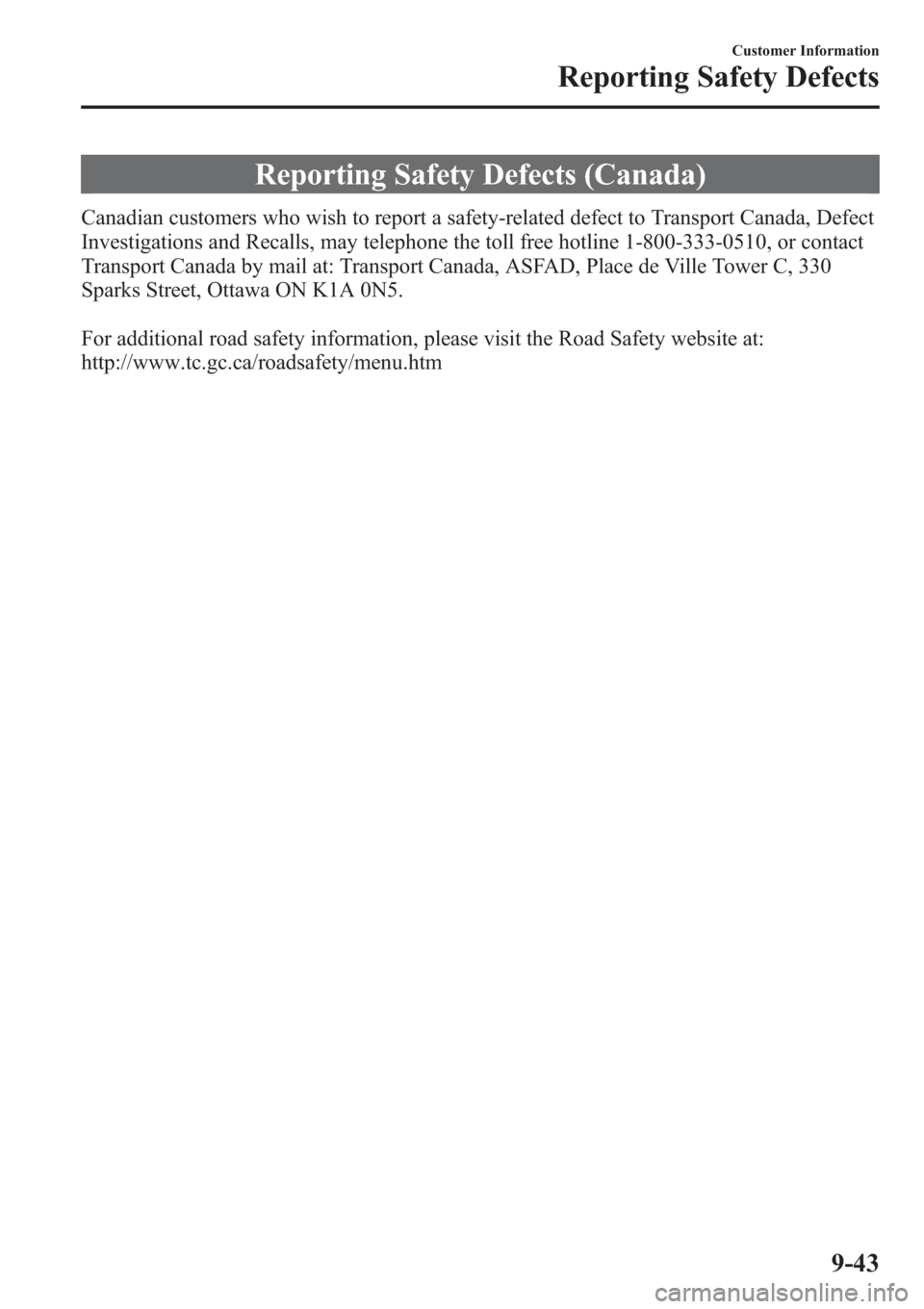
Reporting Safety Defects (Canada)
Canadian customers who wish to report a safety-related defect to Transport Canada, Defect
Investigations and Recalls, may telephone the toll free hotline 1-800-333-0510, or contact
Transport Canada by mail at: Transport Canada, ASFAD, Place de Ville Tower C, 330
Sparks Street, Ottawa ON K1A 0N5.
For additional road safety information, please visit the Road Safety website at:
http://www.tc.gc.ca/roadsafety/menu.htm
Customer Information
Reporting Safety Defects
9-43